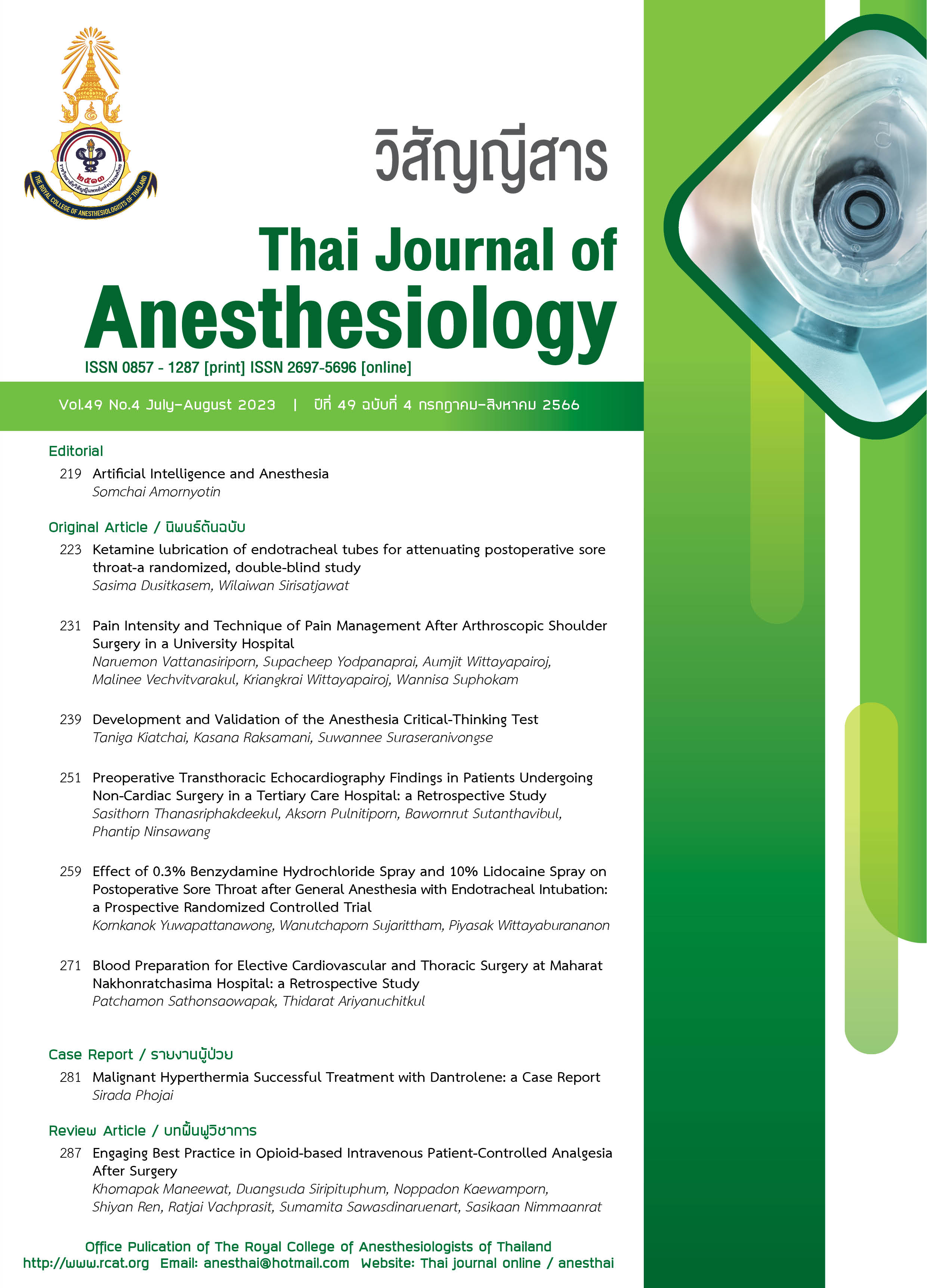Artificial Intelligence and Anesthesia
Main Article Content
Abstract
The introduction of new drugs, equipment, techniques and technologies in the anesthesia practice has seen significant advancements in recent years. To date, various innovations including in anesthesia and surgery are available.1 An advance in medical technology has revolutionized the way health care is distributed to the patients. Artificial intelligence (AI) and telemedicine have been used for a variety of medical services. Interestingly, the spread of the coronavirus disease (COVID-19) pandemic has given an enhancement to the adoption of telemedicine worldwide.2 AI is the science of building computer systems that can imitate the human intelligence. Several previous reviews indicated that AI-enabled decision support systems, when implemented appropriately, could assess in enhancing the patient safety by improving error recognition, patient stratification and drug management.
Article Details

This work is licensed under a Creative Commons Attribution-NonCommercial-NoDerivatives 4.0 International License.
References
Amornyotin S. Anesthesia innovation: mini-review of an intravenous sedation for gastrointestinal endoscopy. Adv Res Gastroentero Hepatol. 2017;4:555636.
Bellini V, Valente M, Gaddi AV, Pelosi P, Bignami EG. Artificial intelligence and telemedicine in anesthesia-potential and problems. Minerva Anestesiol. 2022;88:729-34.
Choudhury A, Asan O. Role of artificial intelligence in patient safety outcomes: systematic literature review. JMIR Med Inform. 2020;8:e18599.
Singh M, Nath G. Artificial intelligence and anesthesia: a narrative review. Saudi J Anaesth. 2022;16:86-93.
Kendale S, Kulkarni P, Rosenberg AD, Wang J. Supervised machine-learning predictive analytics for prediction of postinduction hypotension. Anesthesiology. 2018;129:675-88.
Tighe PJ, Badiyan SJ, Luria I, Lampotang S, Parekattil S. Robot-assisted airway support: a simulated case. Anesth Analg. 2010;111:929-31.
McKendrick M, Yang S, McLeod GA. The use of artificial intelligence and robotics in regional anaesthesia. Anaesthesia. 2021;76(Suppl1):171-81.
Cascella M, Tracey MC, Petrucci E, Bignami EG. Exploring artificial intelligence in anesthesia: a primer on ethics, and clinical applications. Surgeries. 2023;4:264-74.
Connor CW, Segal S. Accurate classification of difficult intubation by computerized facial analysis. Anesth Analg. 2011;112:84-93.
Freundlich RE, Grondin L, Tremper KK, Saran KA, Kheterpal S. Automated electronic reminders to prevent miscommunication among primary medical, surgical and anesthesia providers: a root cause analysis. BMJ Qual Saf. 2012;21:850-4.
Hashimoto DA, Witkowski E, Gao L, Meireles O, Rosman G. Artificial intelligence in anesthesiology: current techniques, clinical applications, and limitations. Anesthesiology. 2020;132:379-94.
Wang R, Wang S, Duan N, Wang Q. From patient-controlled analgesia to artificial intelligence‑assisted patient‑controlled analgesia: practices and perspectives. Front Med. 2020;7:145.
Shetti AN, Kumar AR, Nagaraj AH, Banerjee S, Ashwin AB, Mohamed NS. Anesthesiology’s next frontier: exploring the boundless potential of artificial intelligence. Int J Pharm Chem Anal. 2023;10:3-7.
Henckert D, Malorgio A, Schweiger G, et al. Attitudes of anesthesiologists toward artificial intelligence in anesthesia: a multicenter, mixed qualitative-quantitative study. J Clin Med. 2023;12:2096.
Maheshwari K, Cywinski JB, Papay F, Khanna AK, Mathur P. Artificial intelligence for perioperative medicine: perioperative intelligence. Anesth Analg. 2023;136:637-45.

